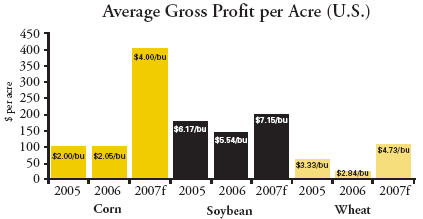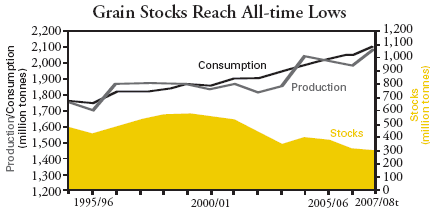| Home | About Us | Resources | Archive | Free Reports | Market Window |
"Agflation" and the Looming Grain CrisisBy
Friday, August 17, 2007
If you've done any food shopping lately, it's been hard not to notice the phenomenon known as "agflation." The prices of all kinds of meat are up. So is the price for cereals – Kellogg's and General Mills have raised their prices. Orange juice, eggs, and milk – all up significantly. You see it perhaps most prominently in higher prices for corn and wheat. Wheat recently reached an 11-year high. Corn topped a 10-year mark last year. As a result, once forlorn places such as Iowa are hot. Eager investors lurk about like bag snatchers at a railway station. They are looking to scoop up farmland. It's no wonder since running a farm is a good business again. Take a look at the chart below of average gross profit per acre (U.S.).
This prosperity spills over to related industries, like a freshly poured lager that overruns the sides of a beer mug. Agricultural equipment makers are sopping up some of that prosperity, too. Farmers need tractors. They need tires for those tractors. They need irrigation equipment. Basically, anybody who sells anything to farmers is doing all right. Including the makers of fertilizers. The question that may come to mind is: "Now what?" I have some thoughts. Shocking as it seems, I think we're only just getting started... World population growth is still putting more demands on food production. Then there is increased prosperity in China and India and other parts of the world. The result is more people with more money in their pockets. And these people want to eat more meat. That stimulates grain production even more. More grain production means more fertilizer use. Global grain stocks were already low two years ago. Remarkably, they are lower now:
Doane Advisory Services notes that forecasts call for grain inventories to reach their lowest level in modern history by the end of this crop year. Grain production should reach a new all-time high this year at 1.66 trillion tons. (Drought conditions throughout much of the U.S. don't bode well for this forecast, by the way). Yet demand is growing faster, to about 1.68 trillion tons. In three of the last four years, demand has topped production and grain stocks have fallen. Another big factor in all of this is the rush for biofuels – in particular, ethanol. Ethanol production should devour about one fifth of America's corn crop. The rush to plant corn is a great boon for fertilizer makers. Corn alone accounts for about 40% of U.S. fertilizer use. Plus, many farmers have dropped the standard corn-soybean crop rotation in favor of continuous corn planting. In sum, the agricultural boom has the wind in its sails. This is the sort of backdrop that's allowed readers of my newsletter – Capital & Crisis – to nearly triple their money in Agrium, the giant fertilizer play, in the last two years. Bottom line: As the trends I've described play out, I think Agrium – and many other "agflation" stocks – will double and triple over the years. Good investing, Chris MayerMarket NotesTHE CARRY TRADE VIOLENTLY UNWINDS "The market is in panic mode," exclaims one currency trader to Bloomberg. Yesterday, the currency markets experienced their most volatile trading day since the Russian default of 1998. Back then, the yen gained 20% in less than two months against the dollar, including a one-day gain of 6.7% on October 7. Yesterday, the yen gained more than 7% against the New Zealand and Australian currencies, 3% versus the euro, and 2.7% against the dollar. The New Zealand dollar is the carry-trade favorite. So far this week, it's lost 15% against the yen. The chart below shows the trade-weighted Japanese yen index. As you can see, the yen is now close to its highest level since May 2006. |
Recent Articles
|



